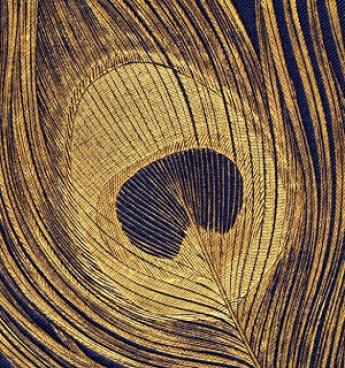The Art of American Book Covers - An Iconic Book Cover From 1876

By Richard Minsky
Gold stamped peacock feather on blue cloth over beveled boards. It is a brilliant example of the engraver’s art - both in the quality of technique used to execute it, and the illumination that emanates from the image. The extremely fine detailing in the stamping die makes the image shimmer as the book is held, with even slight movements causing one part or another to flash more brightly, and creates illusionistic dimensionality with flat gold stamping that made me touch it to see if it’s embossed.
The New Day. A poem in Songs and Sonnets, by Richard Watson Gilder. Illustrations engraved by Henry Marsh. New York: Scribner, Armstrong, and Company, 1876. 17.8 x 13.5 cm (Design often attributed to Helena DeKay Gilder)
1. The only credit given in the book is at the end of the contents, on the last page (p. 112): “The Decorations of this volume were engraved by Mr Henry Marsh.” Letters by Richard Gilder (arranged for publication by his daughter) indicate that Marsh based his engravings on Mrs. Gilder’s drawings. I have neither seen the drawings nor located them, so can’t attest to whether the engravings attempt to reproduce them, are suggested by them, or have little in common with them.
Enlarged detail from The New Day. This peacock feather design has luminance achieved by hand engraving the lines at different angles, and crosshatching with different textures. Stamped in fine gold leaf, it is as beautiful and satisfying to look at as a master’s brushwork on canvas.
2. This design has been attributed to the author’s wife, Helena deKay Gilder, by Willman Spawn and others. For example, the work by Randall Silverman at the University of Utah: “Connoisseurship of Nineteenth and Early Twentieth Century Publishers’ Bookbindings," p. 28: “As of this writing, Helen deKay Gilder is believed to be the first woman to design a publishers’ binding.”
The earliest commentary in my reference collection has no attribution for the design. In the 1894 pamphlet issued by The Grolier Club in conjunction with their exhibition Commercial Bookbindings, this volume follows the 1872 Fly-Leaves (see this blog entry).
Four years later, in 1876, was published the next book among those chosen as in some sense types. This is an edition of “The New Day,” by Mr. R. W. Gilder, which has a purple cloth* cover stamped in gold with a peacock’s feather, the color showing through the gold lines with an iridescent effect quite realistic.
The style of the feather on the cover is nearly identical to peacock feather illustrations on pages 7, 37, 81 and 105 of the book. But that does not mean that either Helena or Richard came up with the idea of using a single large feather coming diagonally from the corner. Perhaps it was thought of as a solo corner fleuron, reinvented from a Renaissance binding. It bears more than passing similarity to several corner tools I have used in hand binding leather books in period styles.
Dartmouth College has many letters from both Gilders to Augustus Saint-Gaudens. Augustus was 23 when The New Day was published, and that was during the time they (Augustus, with Helena and Richard Gilder) founded The Society of American Artists (which apparently started with meetings at the Gilders’ house in 1874 and was established June 1, 1877). I believe Whistler was also in with Gilder, and of course Peacock feathers were a big motif of his at that time (he did The Peacock Room in 1876-77).
In 1875, while The New Day was being prepared for publication, Saint-Gaudens shared a New York studio with the artist David Maitland Armstrong, whose daughter Margaret was 8 years old. Margaret Armstrong developed into one of the era's most prominent book cover artists.
Mrs. Gilder is not known to have designed any other bindings. Perhaps a skilled artisan like Marsh could have engraved the stamping die for the cover. He was known for his delicate engravings of insect life, but those were wood engravings. Whether he also engraved brass or other hard metals that could be used for a die to stamp gold is presently unknown. His Boston company was Hitchcock & Marsh. If you have access to any information about what sort of business they were in, or if they produced stamping dies, please let me know.
* The copy I photographed above is blue. I have not seen a purple copy listed. Perhaps after 100 years the chemistry of the purple dye has changed, or maybe copies of the edition were issued on blue cloth. It is also possible that this color was called purple by the writer in 1894.
***
ILAB is proud to present a series of most interesting articles originally published on Richard Minsky’s blog The Art of American Book Covers.
Richard Minsky has been making and remaking artists’ books for over fifty years. His tremendous work is documented in The Book Art of Richard Minsky, published by George Braziller Inc. in 2011. Richard Minsky founded the Center for Book Arts in 1974. His work has been shown around the world and remains in public collections, including the National Gallery of Art and The Victoria and Albert Museum. He has received many fellowships, grants and awards of recognition, including several from the National Endowment for the Arts.
Text and images Copyright © 2009 Richard Minsky. All rights reserved. Used with permission.

